Buildings can be Reused for other purposes and add a new value to the community. Because the original use is no longer needed, a new use for an attractive, well-constructed building is to everyone’s advantage.
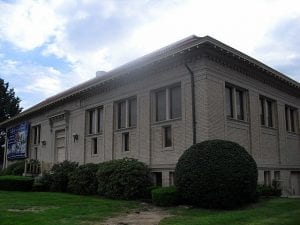 The Renaissance Revival style building was designed by Edward Tilton, who also designed the Central Library. It closed in the early 1970s and sat vacantly and deteriorated. There were those who advocated for its demolition. Fortunately, Saint George Greek Orthodox Cathedral purchased it and adapted it into its Greek Cultural Center.
The Renaissance Revival style building was designed by Edward Tilton, who also designed the Central Library. It closed in the early 1970s and sat vacantly and deteriorated. There were those who advocated for its demolition. Fortunately, Saint George Greek Orthodox Cathedral purchased it and adapted it into its Greek Cultural Center.
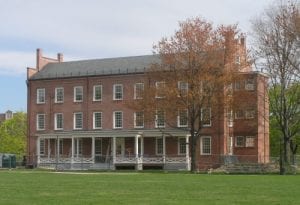
OLYMPUS DIGITAL CAMERA
One of the oldest buildings remaining in Springfield, the West Arsenal is the oldest building in the Springfield Armory, the institution which catapulted Springfield from a sleepy town to a vibrant industrial city. It had deteriorated but was recently renovated for the State Police Training Academy.
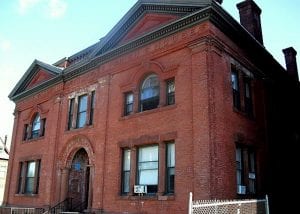 The Colonial Revival style building was designed by F. R. Richmond for the congregation which once occupied Saint George’s Cathedral. The building closed when the new Greek Cultural Center opened. It sat vacant for many years before being renovated for housing.
The Colonial Revival style building was designed by F. R. Richmond for the congregation which once occupied Saint George’s Cathedral. The building closed when the new Greek Cultural Center opened. It sat vacant for many years before being renovated for housing.
Built-in the Colonial Revival style as the third YMCA in Springfield, the building closed in the late 1960s when a new facility opened. It became a lodging house before closing and then sat vacantly. Demolition of the building for a parking garage was considered, but it was saved by its status on the National Register of Historic Places, and the new owner determined to renovate it into apartments.
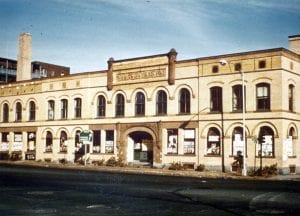 The firm of Gardner, Pyne, & Gardner designed the Renaissance Revival building with its fanciful terra cotta images of trolley cars and carved trolley wheels with lightning bolts. By the 1970s, the building was vacant and considered for demolition but renovated for offices and bus servicing uses.
The firm of Gardner, Pyne, & Gardner designed the Renaissance Revival building with its fanciful terra cotta images of trolley cars and carved trolley wheels with lightning bolts. By the 1970s, the building was vacant and considered for demolition but renovated for offices and bus servicing uses.
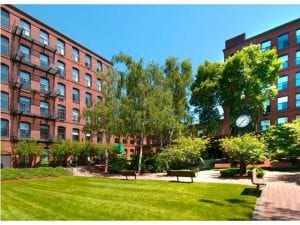 The large complex of brick factory buildings began as a slipper factory, became a paper collar factory, and then in the 1880s was the home for the Milton Bradley Toy Company. The manufacturing operation moved to the suburbs in the 1960s and the complex was used for warehousing until being sold in 1982. It was then converted into apartments, now known as Stockbridge Court.
The large complex of brick factory buildings began as a slipper factory, became a paper collar factory, and then in the 1880s was the home for the Milton Bradley Toy Company. The manufacturing operation moved to the suburbs in the 1960s and the complex was used for warehousing until being sold in 1982. It was then converted into apartments, now known as Stockbridge Court.
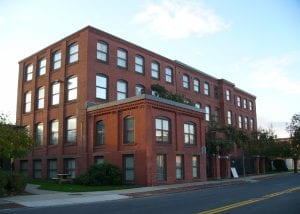 The northern portion of Brightwood, near the Chicopee line, and bisected by the railroad, began to industrialize in the late 19th century. Companies such as Wason Car, Bausch-Harris Machine Tools, and Powers Paper established facilities in the area. Although many buildings have disappeared, some have been adapted into new office uses.
The northern portion of Brightwood, near the Chicopee line, and bisected by the railroad, began to industrialize in the late 19th century. Companies such as Wason Car, Bausch-Harris Machine Tools, and Powers Paper established facilities in the area. Although many buildings have disappeared, some have been adapted into new office uses.
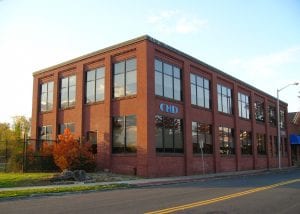
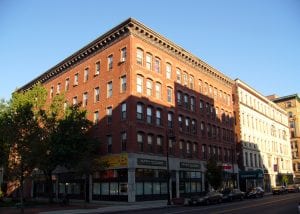 The two large brick buildings on the corner of Worthington and Taylor Streets were part of the commercial and industrial growth near the railroad. Marginally used by the 1970s, the buildings were slated to become part of a larger new housing complex called Morgan Square. During construction, they were ravaged by fire but renovations took place nonetheless.
The two large brick buildings on the corner of Worthington and Taylor Streets were part of the commercial and industrial growth near the railroad. Marginally used by the 1970s, the buildings were slated to become part of a larger new housing complex called Morgan Square. During construction, they were ravaged by fire but renovations took place nonetheless.
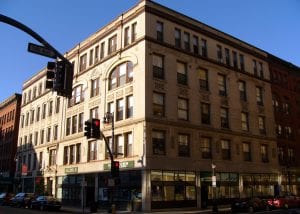
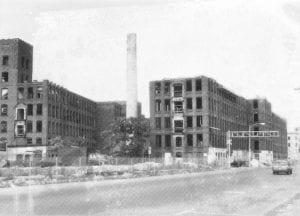 The creation of the rail line from downtown Springfield to New London, CT spurred development. The Bullard Repeating Arms Company established a facility that was expanded over the years and then purchased by the Indian Motorcycle Company, once the largest maker of motorcycles in the world. The plant closed in 1948. By the 1970s, the facility was vacant and deteriorated and the City planned to demolish it. The portion west of the tracks was heavily damaged by an arson fire and razed. The eastern portions along Wilbraham Road and Rutland Street were renovated for housing. Much of the State Street wing remains vacant.
The creation of the rail line from downtown Springfield to New London, CT spurred development. The Bullard Repeating Arms Company established a facility that was expanded over the years and then purchased by the Indian Motorcycle Company, once the largest maker of motorcycles in the world. The plant closed in 1948. By the 1970s, the facility was vacant and deteriorated and the City planned to demolish it. The portion west of the tracks was heavily damaged by an arson fire and razed. The eastern portions along Wilbraham Road and Rutland Street were renovated for housing. Much of the State Street wing remains vacant.
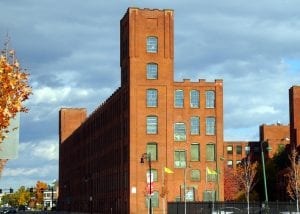
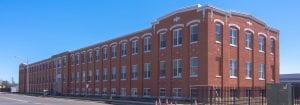 This structure was built as the administration building for the Westinghouse Electric Manufacturing Co. The building has been a landmark in the East Springfield neighborhood since its construction in 1926. The building stretches 300 feet along Page Boulevard and is 54 feet wide, 48,000 square foot building, and was designed to hold 800 office workers. In the late 1960s, the plant was divested by Westinghouse and became the Springfield Industrial Center, until it was sold in 2010 to be redeveloped as a shopping center. Plans moved forward to demolish all the structures on the site when a casino developer purchased them for a proposed casino. The administration building somehow survived being demolished and the current owner, CRRC MA, has saved the building and rehabilitated it for their own use.
This structure was built as the administration building for the Westinghouse Electric Manufacturing Co. The building has been a landmark in the East Springfield neighborhood since its construction in 1926. The building stretches 300 feet along Page Boulevard and is 54 feet wide, 48,000 square foot building, and was designed to hold 800 office workers. In the late 1960s, the plant was divested by Westinghouse and became the Springfield Industrial Center, until it was sold in 2010 to be redeveloped as a shopping center. Plans moved forward to demolish all the structures on the site when a casino developer purchased them for a proposed casino. The administration building somehow survived being demolished and the current owner, CRRC MA, has saved the building and rehabilitated it for their own use.
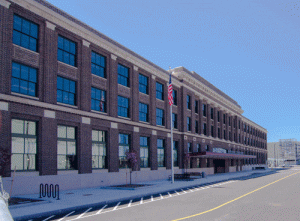 Union Station was constructed by the Boston & Albany Railroad to replace a pair of Victorian-era stations on either side of the tracks. It was designed in the Classical Revival Style by the Boston architectural firm of Feldheimer & Wagner. The building had been unused for more than 40 years but has undergone a multi-million-dollar refurbishment to serve as an intermodal transportation center.
Union Station was constructed by the Boston & Albany Railroad to replace a pair of Victorian-era stations on either side of the tracks. It was designed in the Classical Revival Style by the Boston architectural firm of Feldheimer & Wagner. The building had been unused for more than 40 years but has undergone a multi-million-dollar refurbishment to serve as an intermodal transportation center.
